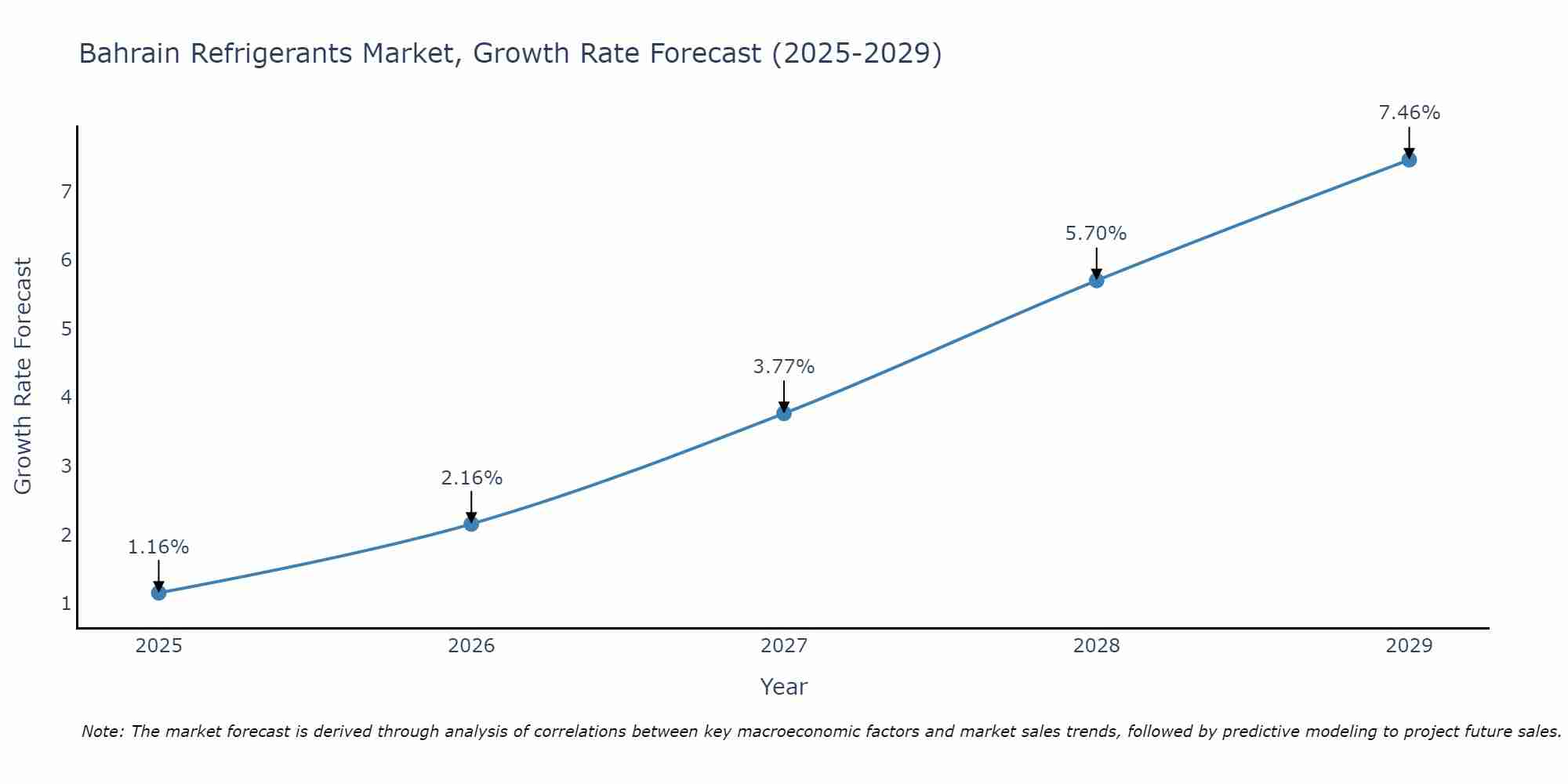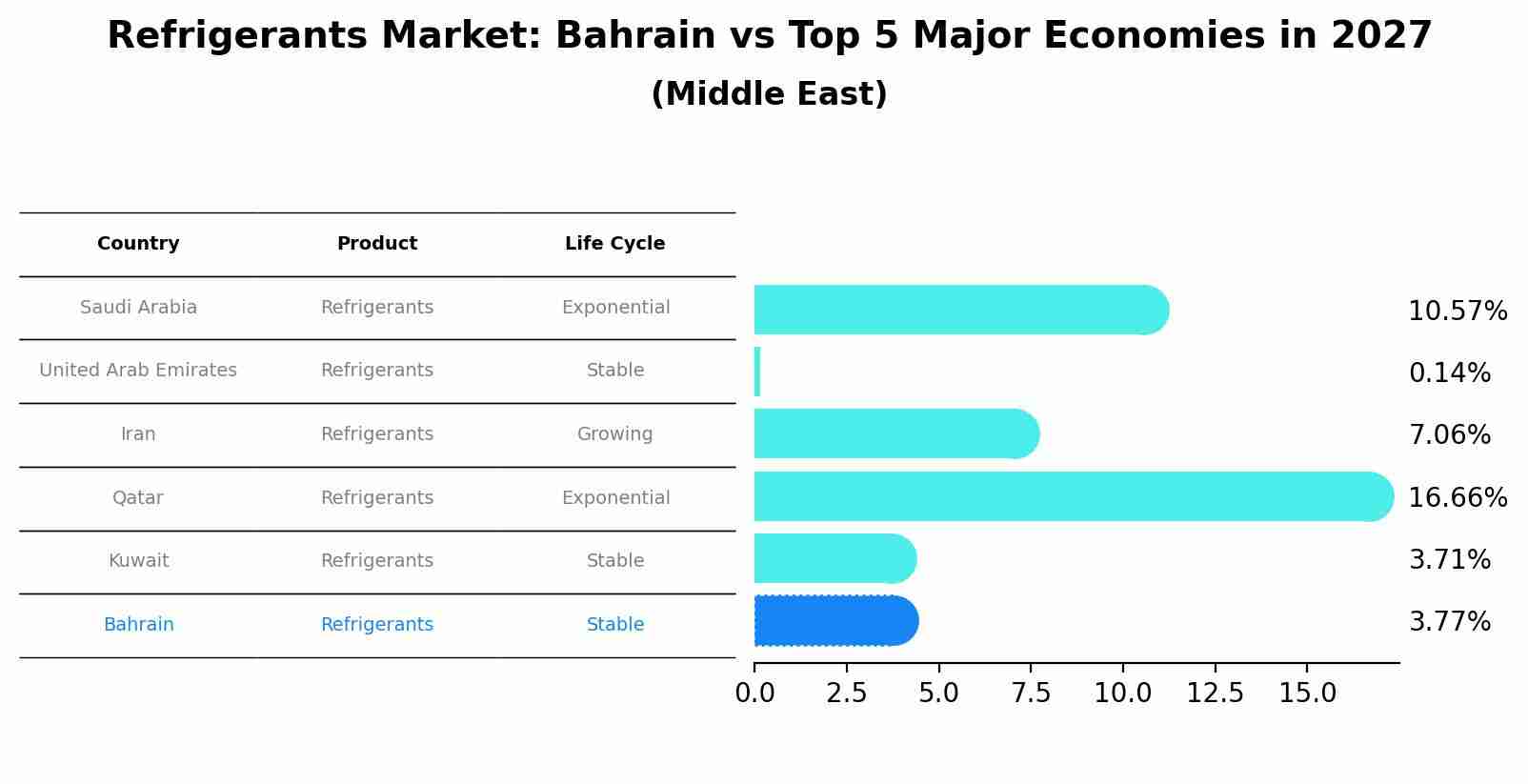Bahrain Refrigerants Market Outlook | Revenue, Trends, Size, Companies, Share, Forecast, Analysis, COVID-19 IMPACT, Growth, Value & Industry
| Product Code: ETC344024 | Publication Date: Aug 2022 | Updated Date: Apr 2025 | Product Type: Market Research Report | |
| Publisher: 6Wresearch | Author: Dhaval Chaurasia | No. of Pages: 75 | No. of Figures: 35 | No. of Tables: 20 |
Bahrain Refrigerants Market Size Growth Rate
The Bahrain Refrigerants Market is likely to experience consistent growth rate gains over the period 2025 to 2029. The growth rate starts at 1.16% in 2025 and reaches 7.46% by 2029.

Refrigerants Market: Bahrain vs Top 5 Major Economies in 2027 (Middle East)
By 2027, Bahrain's Refrigerants market is forecasted to achieve a stable growth rate of 3.77%, with Saudi Arabia leading the Middle East region, followed by United Arab Emirates, Iran, Qatar and Kuwait.

Bahrain Refrigerants Market Synopsis
The refrigerants market in Bahrain is driven by the demand for air conditioning and refrigeration in both residential and commercial sectors. With hot climatic conditions, cooling systems are essential, and newer, low-GWP (global warming potential) refrigerants are gaining attention. Regulatory pressures and environmental sustainability are leading to the gradual phase-out of older, ozone-depleting substances.
Trends of the market
The refrigerants market in Bahrain is evolving with the countrys commitment to phase down hydrofluorocarbons (HFCs) under the Kigali Amendment. There`s rising demand for low-GWP (Global Warming Potential) refrigerants in air conditioning, commercial refrigeration, and automotive cooling systems. HFOs and natural refrigerants like CO? and ammonia are gaining traction, supported by regulatory incentives and energy efficiency programs.
Challenges of the market
The refrigerants market in Bahrain faces challenges primarily driven by environmental regulations. The global push to phase out high-GWP (global warming potential) refrigerants, such as HFCs, in favor of more eco-friendly alternatives has caused a shift in the market. Bahrains refrigerant market is impacted by the need to comply with international agreements such as the Kigali Amendment to the Montreal Protocol, which calls for the phase-down of certain refrigerants. This regulatory pressure, combined with the rising demand for energy-efficient cooling solutions, is pushing manufacturers to invest in new technologies and alternative refrigerants, thereby adding complexity and cost to the market.
Investment opportunities in the Market
The expanding HVAC and automotive sectors fuel demand for refrigerants. Bahrains hot climate makes this a consistent-growth sector. Investment in eco-friendly refrigerants, gas recovery services, and servicing infrastructure is encouraged, especially with growing environmental regulations and green building standards.
Government Policy of the market
The refrigerants market in Bahrain is subject to environmental regulations that align with international agreements such as the Kigali Amendment to the Montreal Protocol, which aims to phase out harmful chemicals like Hydrochlorofluorocarbons (HCFCs). The government enforces regulations to ensure that refrigerants used in air conditioning and refrigeration systems are non-toxic and non-ozone-depleting. Policies also promote the adoption of eco-friendly refrigerants, such as hydrofluoroolefins (HFOs), to reduce the environmental impact of refrigeration and air conditioning systems.
Key Highlights of the Report:
- Bahrain Refrigerants Market Outlook
- Market Size of Bahrain Refrigerants Market, 2021
- Forecast of Bahrain Refrigerants Market, 2031
- Historical Data and Forecast of Bahrain Refrigerants Revenues & Volume for the Period 2018 - 2031
- Bahrain Refrigerants Market Trend Evolution
- Bahrain Refrigerants Market Drivers and Challenges
- Bahrain Refrigerants Price Trends
- Bahrain Refrigerants Porter's Five Forces
- Bahrain Refrigerants Industry Life Cycle
- Historical Data and Forecast of Bahrain Refrigerants Market Revenues & Volume By Type for the Period 2018 - 2031
- Historical Data and Forecast of Bahrain Refrigerants Market Revenues & Volume By Halocarbons for the Period 2018 - 2031
- Historical Data and Forecast of Bahrain Refrigerants Market Revenues & Volume By Azeotropic for the Period 2018 - 2031
- Historical Data and Forecast of Bahrain Refrigerants Market Revenues & Volume By Zeotropic for the Period 2018 - 2031
- Historical Data and Forecast of Bahrain Refrigerants Market Revenues & Volume By Carbon Dioxide for the Period 2018 - 2031
- Historical Data and Forecast of Bahrain Refrigerants Market Revenues & Volume By Hydrocarbon for the Period 2018 - 2031
- Historical Data and Forecast of Bahrain Refrigerants Market Revenues & Volume By Inorganic for the Period 2018 - 2031
- Historical Data and Forecast of Bahrain Refrigerants Market Revenues & Volume By Application for the Period 2018 - 2031
- Historical Data and Forecast of Bahrain Refrigerants Market Revenues & Volume By AC for the Period 2018 - 2031
- Historical Data and Forecast of Bahrain Refrigerants Market Revenues & Volume By Refrigeration for the Period 2018 - 2031
- Bahrain Refrigerants Import Export Trade Statistics
- Market Opportunity Assessment By Type
- Market Opportunity Assessment By Application
- Bahrain Refrigerants Top Companies Market Share
- Bahrain Refrigerants Competitive Benchmarking By Technical and Operational Parameters
- Bahrain Refrigerants Company Profiles
- Bahrain Refrigerants Key Strategic Recommendations
Frequently Asked Questions About the Market Study (FAQs):
1 Executive Summary |
2 Introduction |
2.1 Key Highlights of the Report |
2.2 Report Description |
2.3 Market Scope & Segmentation |
2.4 Research Methodology |
2.5 Assumptions |
3 Bahrain Refrigerants Market Overview |
3.1 Bahrain Country Macro Economic Indicators |
3.2 Bahrain Refrigerants Market Revenues & Volume, 2021 & 2031F |
3.3 Bahrain Refrigerants Market - Industry Life Cycle |
3.4 Bahrain Refrigerants Market - Porter's Five Forces |
3.5 Bahrain Refrigerants Market Revenues & Volume Share, By Type, 2021 & 2031F |
3.6 Bahrain Refrigerants Market Revenues & Volume Share, By Application, 2021 & 2031F |
4 Bahrain Refrigerants Market Dynamics |
4.1 Impact Analysis |
4.2 Market Drivers |
4.3 Market Restraints |
5 Bahrain Refrigerants Market Trends |
6 Bahrain Refrigerants Market, By Types |
6.1 Bahrain Refrigerants Market, By Type |
6.1.1 Overview and Analysis |
6.1.2 Bahrain Refrigerants Market Revenues & Volume, By Type, 2021-2031F |
6.1.3 Bahrain Refrigerants Market Revenues & Volume, By Halocarbons, 2021-2031F |
6.1.4 Bahrain Refrigerants Market Revenues & Volume, By Azeotropic, 2021-2031F |
6.1.5 Bahrain Refrigerants Market Revenues & Volume, By Zeotropic, 2021-2031F |
6.1.6 Bahrain Refrigerants Market Revenues & Volume, By Carbon Dioxide, 2021-2031F |
6.1.7 Bahrain Refrigerants Market Revenues & Volume, By Hydrocarbon, 2021-2031F |
6.1.8 Bahrain Refrigerants Market Revenues & Volume, By Inorganic, 2021-2031F |
6.2 Bahrain Refrigerants Market, By Application |
6.2.1 Overview and Analysis |
6.2.2 Bahrain Refrigerants Market Revenues & Volume, By AC, 2021-2031F |
6.2.3 Bahrain Refrigerants Market Revenues & Volume, By Refrigeration, 2021-2031F |
7 Bahrain Refrigerants Market Import-Export Trade Statistics |
7.1 Bahrain Refrigerants Market Export to Major Countries |
7.2 Bahrain Refrigerants Market Imports from Major Countries |
8 Bahrain Refrigerants Market Key Performance Indicators |
9 Bahrain Refrigerants Market - Opportunity Assessment |
9.1 Bahrain Refrigerants Market Opportunity Assessment, By Type, 2021 & 2031F |
9.2 Bahrain Refrigerants Market Opportunity Assessment, By Application, 2021 & 2031F |
10 Bahrain Refrigerants Market - Competitive Landscape |
10.1 Bahrain Refrigerants Market Revenue Share, By Companies, 2021 |
10.2 Bahrain Refrigerants Market Competitive Benchmarking, By Operating and Technical Parameters |
11 Company Profiles |
12 Recommendations |
13 Disclaimer |
- Single User License$ 1,995
- Department License$ 2,400
- Site License$ 3,120
- Global License$ 3,795
Search
Related Reports
- Portugal Electronic Document Management Market (2025-2031) | Strategy, Consumer Insights, Analysis, Investment Trends, Opportunities, Growth, Size, Share, Industry, Revenue, Segments, Value, Segmentation, Supply, Forecast, Restraints, Outlook, Competition, Drivers, Trends, Demand, Pricing Analysis, Competitive, Strategic Insights, Companies, Challenges
- France Electronic Document Management Market (2025-2031) | Strategy, Consumer Insights, Analysis, Investment Trends, Opportunities, Growth, Size, Share, Industry, Revenue, Segments, Value, Segmentation, Supply, Forecast, Restraints, Outlook, Competition, Drivers, Trends, Demand, Pricing Analysis, Competitive, Strategic Insights, Companies, Challenges
- Portugal Occupational Health & Safety Services Market (2025-2031) | Strategy, Consumer Insights, Analysis, Investment Trends, Opportunities, Growth, Size, Share, Industry, Revenue, Segments, Value, Segmentation, Supply, Forecast, Restraints, Outlook, Competition, Drivers, Trends, Demand, Pricing Analysis, Competitive, Strategic Insights, Companies, Challenges
- Netherlands Occupational Health and Safety Services Market (2025-2031) | Strategy, Consumer Insights, Analysis, Investment Trends, Opportunities, Growth, Size, Share, Industry, Revenue, Segments, Value, Segmentation, Supply, Forecast, Restraints, Outlook, Competition, Drivers, Trends, Demand, Pricing Analysis, Competitive, Strategic Insights, Companies, Challenges
- Belgium and Luxembourg Facility Management Market (2025-2031) | Strategy, Consumer Insights, Analysis, Investment Trends, Opportunities, Growth, Size, Share, Industry, Revenue, Segments, Value, Segmentation, Supply, Forecast, Restraints, Outlook, Competition, Drivers, Trends, Demand, Pricing Analysis, Competitive, Strategic Insights, Companies, Challenges
- Russia Women Intimate Apparel Market (2025-2031) | Strategy, Consumer Insights, Analysis, Investment Trends, Opportunities, Growth, Size, Share, Industry, Revenue, Segments, Value, Segmentation, Supply, Forecast, Restraints, Outlook, Competition, Drivers, Trends, Demand, Pricing Analysis, Competitive, Strategic Insights, Companies, Challenges
- Africa Chocolate Market (2025-2031) | Size, Share, Trends, Growth, Revenue, Analysis, Forecast, industry & Outlook
- Global Hydroxychloroquine And Chloroquine Market (2025-2031) | Industry, Trends, Size, Outlook, Growth, Value, Companies, Revenue, Analysis, Share, Forecast
- Saudi Arabia Plant Maintenance Market (2025-2031) | Industry, Size, Growth, Revenue, Value, Companies, Forecast, Analysis, Share & Trends
- Taiwan Electric Truck Market (2025-2031) | Outlook, Industry, Revenue, Size, Forecast, Growth, Analysis, Share, Companies, Value & Trends
Industry Events and Analyst Meet
Our Clients
Whitepaper
- Middle East & Africa Commercial Security Market Click here to view more.
- Middle East & Africa Fire Safety Systems & Equipment Market Click here to view more.
- GCC Drone Market Click here to view more.
- Middle East Lighting Fixture Market Click here to view more.
- GCC Physical & Perimeter Security Market Click here to view more.
6WResearch In News
- Doha a strategic location for EV manufacturing hub: IPA Qatar
- Demand for luxury TVs surging in the GCC, says Samsung
- Empowering Growth: The Thriving Journey of Bangladesh’s Cable Industry
- Demand for luxury TVs surging in the GCC, says Samsung
- Video call with a traditional healer? Once unthinkable, it’s now common in South Africa
- Intelligent Buildings To Smooth GCC’s Path To Net Zero













